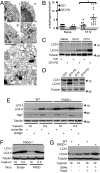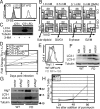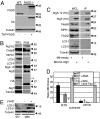FADD and caspase-8 control the outcome of autophagic signaling in proliferating T cells
- PMID: 18946037
- PMCID: PMC2575479
- DOI: 10.1073/pnas.0808597105
FADD and caspase-8 control the outcome of autophagic signaling in proliferating T cells
Abstract
Fas-associated death domain protein (FADD) and caspase-8 (casp8) are vital intermediaries in apoptotic signaling induced by tumor necrosis factor family ligands. Paradoxically, lymphocytes lacking FADD or casp8 fail to undergo normal clonal expansion following antigen receptor cross-linking and succumb to caspase-independent cell death upon activation. Here we show that T cells lacking FADD or casp8 activity are subject to hyperactive autophagic signaling and subvert a cellular survival mechanism into a potent death process. T cell autophagy, enhanced by mitogenic signaling, recruits casp8 through interaction with FADD:Atg5-Atg12 complexes. Inhibition of autophagic signaling with 3-methyladenine, dominant-negative Vps34, or Atg7 shRNA rescued T cells expressing a dominant-negative FADD protein. The necroptosis inhibitor Nec-1, which blocks receptor interacting protein kinase 1 (RIP kinase 1), also completely rescued T cells lacking FADD or casp8 activity. Thus, while autophagy is necessary for rapid T cell proliferation, our findings suggest that FADD and casp8 form a feedback loop to limit autophagy and prevent this salvage pathway from inducing RIPK1-dependent necroptotic cell death. Thus, linkage of FADD and casp8 to autophagic signaling intermediates is essential for rapid T cell clonal expansion and may normally serve to promote caspase-dependent apoptosis under hyperautophagic conditions, thereby averting necrosis and inflammation in vivo.
Conflict of interest statement
The authors declare no conflict of interest.
Figures





References
-
- Walsh CM, Luhrs KA, Arechiga AF. The “fuzzy logic” of the death-inducing signaling complex in lymphocytes. J Clin Immunol. 2003;23:333–353. - PubMed
-
- Varfolomeev EE, et al. Targeted disruption of the mouse Caspase 8 gene ablates cell death induction by the TNF receptors, Fas/Apo1, and DR3 and is lethal prenatally. Immunity. 1998;9:267–276. - PubMed
-
- Zhang J, Cado D, Chen A, Kabra N, Winoto A. Fas-mediated apoptosis and activation-induced T cell proliferation are defective in mice lacking FADD/Mort1. Nature. 1998;392:296–300. - PubMed
-
- Yeh WC, et al. FADD: essential for embryo development and signaling from some, but not all, inducers of apoptosis. Science. 1998;279:1954–1958. - PubMed
Publication types
MeSH terms
Substances
Grants and funding
LinkOut - more resources
Full Text Sources
Other Literature Sources
Molecular Biology Databases
Research Materials
Miscellaneous

